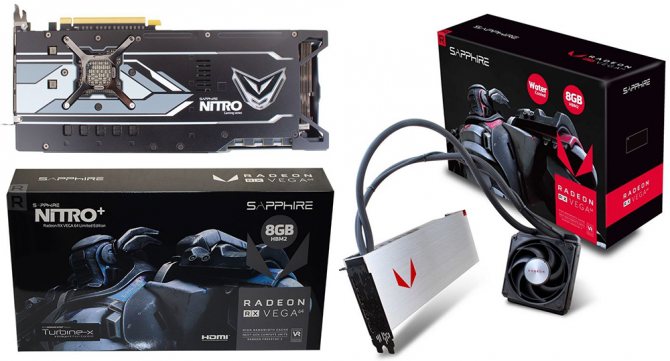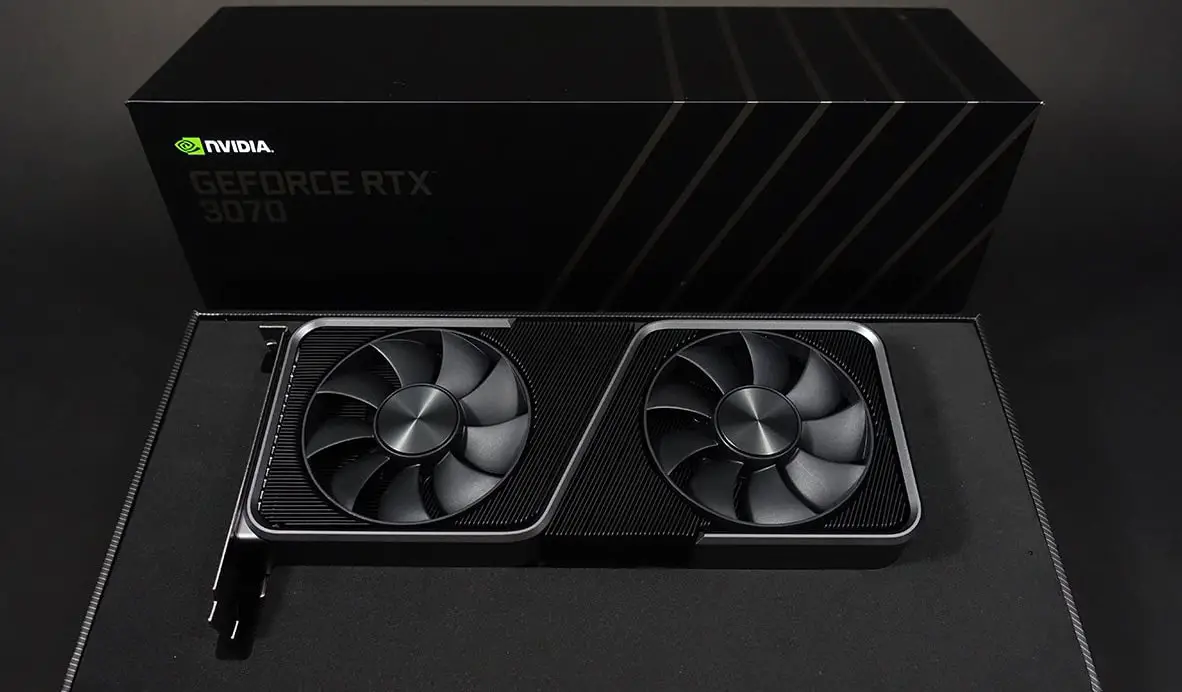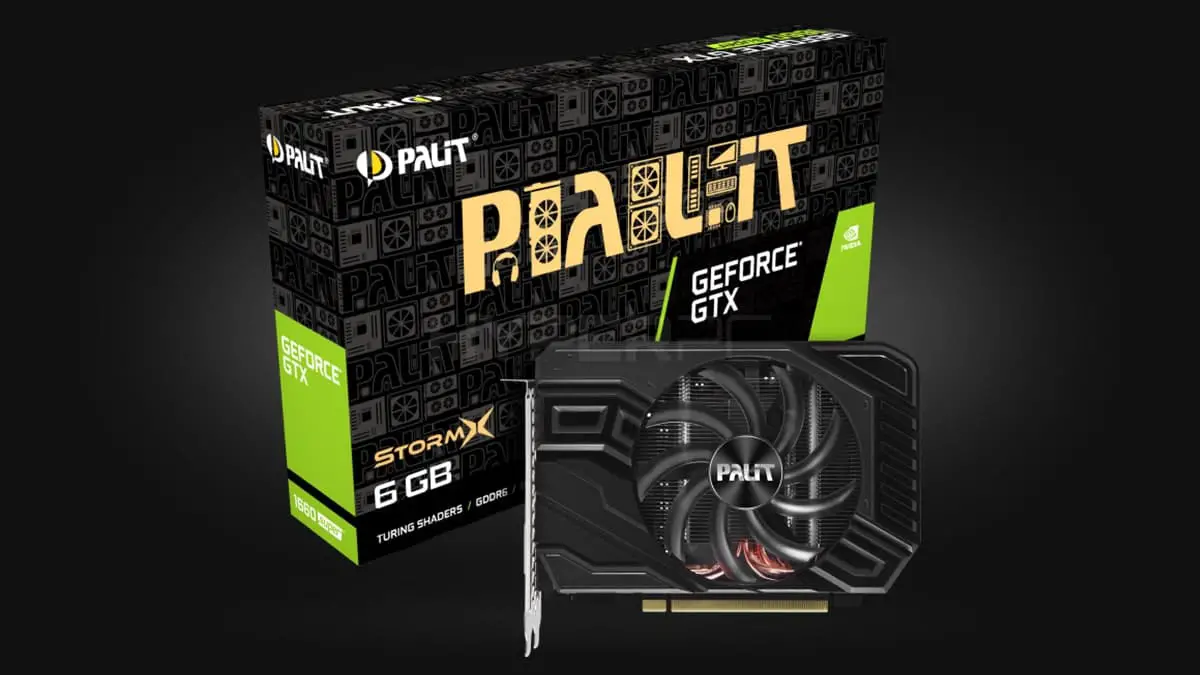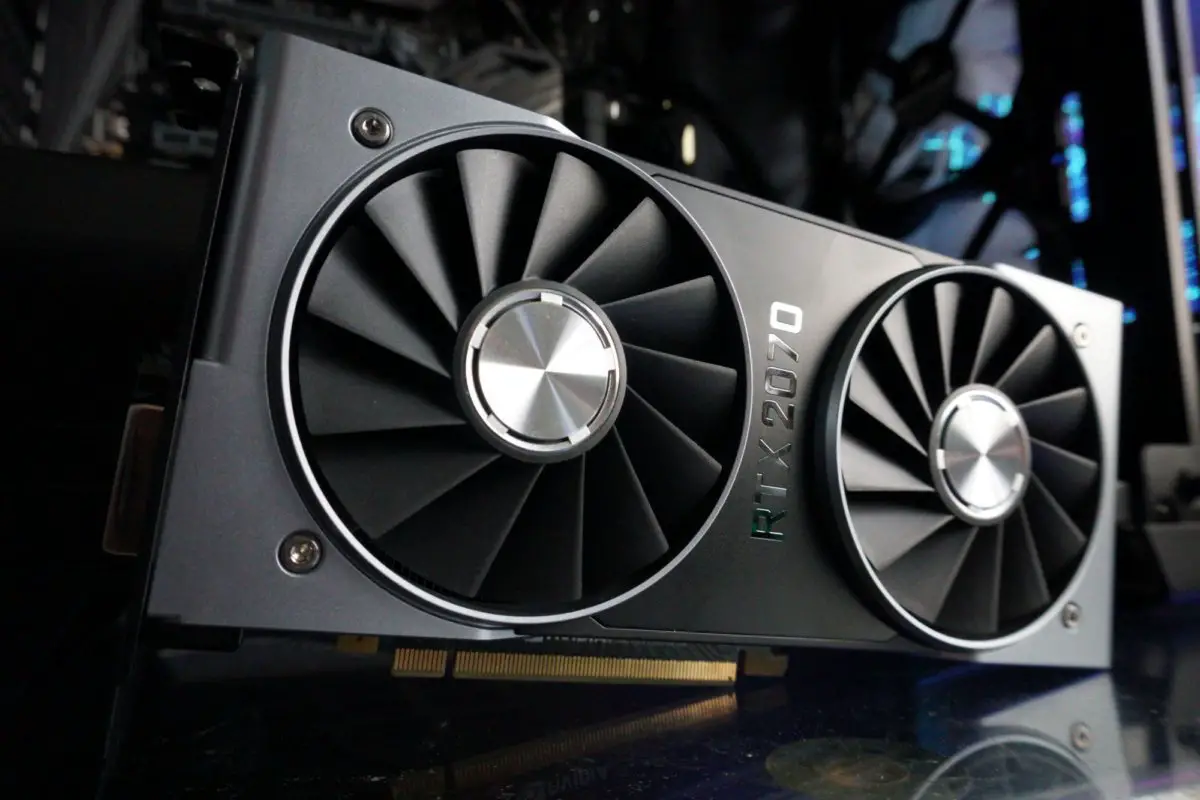Mining Radeon RX Vega M: Review (M GH vsM GL) |Hashrate| Profitability| Specs | Benchmark – Mining on RX Vega 64 – payback and relevance in 2020 The RX Vega 64 graphics card in the mining industry was perceived ambiguously, causing a lot of controversy. On the one hand, this is an excellent device for earning promising cryptocurrencies. On the other hand, it is an unjustifiably expensive purchase with a long payback period, which does not provide any special advantages. In this article, we will consider whether it is worth buying the RX Vega 64 as the best option for mining, and how much profit with a payback can be expected with this video card in 3-4 quarters of 2020.
Mining Radeon RX Vega M: Specifications
The RX Vega 64 video card came out when mining began to gain its popularity. Therefore, it was initially considered not only in terms of gaming performance, but also as a choice for mining cryptocurrencies. The card was positioned as a competitor to the top-end NVidia models, although after the recession in the marketing pressure of the market, the confrontation between Vega 64 and NVidia GTX 1080 / Ti quickly faded away, and not in AMD’s favor.
Specifications RX Vega 64:
- Core frequency – 1247 MHz (and 1546 MHz in boost);
- Memory frequency – 1890 MHz;
- Memory capacity – 8 GB;
- Power consumption – 295W.
It should also be noted that the card requires three 8-pin connectors, which can be considered a disadvantage (the Nitro + version requires only two 8-pin connectors).
In most cases, the cooling system of the RX Vega 64 is made at a fairly high level. The only exception is the version from Gigabyte, which usually receives more complaints than others. Naturally, the overclocking profile for mining will differ from normal or gaming. The optimal ratio of parameters will be the following option, which has already shown its effectiveness:
- Overclocking the core up to 1600+ MHz;
- Overclocking memory up to 1100 MHz (2200);
- Downvolt at 23-24%.
This profile is suitable for most cards, although it is better to check the indicators step by step to avoid possible trouble. The version with lowered core frequencies is only suitable for Ethereum (reduction to 1000-1000 MHz), since memory is much more important for this cryptocurrency than the core frequency. In general, the video card consumes about 200 watts during downwind and overclocking, which makes it quite “gluttonous”.
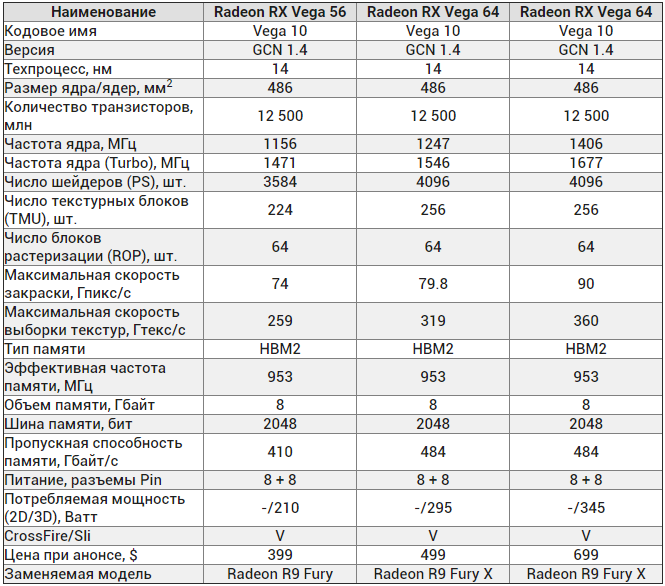
Intel Introduces Core Processors with Radeon RX Vega M Graphics
Intel used the Consumer Electronics Show this year to officially unveil Core processors with Radeon RX Vega M graphics. Back in early November, the first information appeared, but then Intel did not disclose technical specifications. Today, the processors have finally been officially announced. Intel unveils five processors with Radeon RX Vega M graphics.
Of course, Intel customers and users alike would like to see performance gains alongside smaller chip sizes. Gaming laptops no longer stand out a few centimeters thick, and gaming PCs don’t necessarily mean Midi Tower format or more. But solutions with integrated graphics on the CPU did not have high performance. Intel tried to turn things around with HD Graphics in their processors for many years, but in the end the iGPU was only good for video encoding / decoding, but not for modern games.
However, Intel is not alone well aware of the trend towards smaller and thinner laptops. NVIDIA introduced its Max Q initiative last summer. Gaming laptops should be no thicker than 20mm, despite the high-end GPU inside. Of course, NVIDIA is interested in selling its own GPUs, so this approach differs from the goals set by Intel with Core H.
New CPU packaging
With Core processors with Radeon RX Vega M graphics, Intel pushed into previously uncharted territory. The four presented models are just the beginning, others will be announced next. The combination of an 8th Gen Core processor, 4GB HBM2 memory and Radeon RX Vega M graphics is the first mobile application of AMD Vega architecture and HBM2 memory. In the desktop segment, AMD has already unveiled the Radeon RX Vega 56 and 64 graphics cards this summer. The Core H processors became the first retail product to feature Embedded Multi-Die Interconnect Bridge (EMIB) technology.
The package of Core processors with Radeon RX Vega M graphics consists of three chips. Namely, a 4GB HBM2 memory stack, a Radeon RX Vega M Graphics GPU, and an 8th Gen Intel Core processor. The EMIB only connects the HBM2 memory stack to the AMD GPU. EMIB is not an interface or protocol, but a technology for electrically connecting chips. Together with TSMC, AMD uses a similar technology to connect its GPUs to HBM memory stacks on a graphics card substrate. The same goes for NVIDIA, of course.
By integrating GPUs onto CPU packaging using EMIB, Intel was able to reduce chip area by 50%. The package thickness is 1.7 mm, which makes it possible to create very thin laptops based on the chip.
EMIB is a manufacturing technology developed by Intel that allows different crystals to be connected on a single substrate. A similar 2.5D design is suitable for combining crystals created using different technical processes. Through Silicon Vias (TSVs) channels provide high data transfer rates. At the same time, the packing density of individual components is increased, which reduces the space required on the PCB. And allows for more compact designs.
There were similar arguments during the development of High Bandwidth Memory, which is located next to the GPU crystal on the same substrate and is connected via the same Through Silicon Vias (TSVs) channels. Fast memory requires an equally fast interconnect, which is also true for Intel Core H processors. As we noted above, EMIB technology allows you to install chips with different technical processes. For example, a CPU can be manufactured using a 10nm process technology, but a GPU can be manufactured using a 14nm or 12nm process technology at GlobalFoundries factories. Also, this technology significantly reduces the price compared to a silicon substrate. Intel disclosed additional information on EMIB technology at the latest Technology and Manufacturing Group meeting.
Eight PCI Express lanes are used to connect the GPU and CPU. As a result, the throughput is 7.88 GB / s. At first glance, we are faced with a limitation. Indeed, with most combinations of Intel processor with discrete GPU in laptops, we get a full 16 lines. But Intel, apparently, uses the Kaby Lake Refresh cores in this case, equipping them with Radeon RX Vega M graphics. And these processors have only 12 lines for connecting components. Eight are already used for the GPU, which leaves only four lanes on SSDs, Thunderbolt controllers and everything else. However, according to Intel, eight PCI Express lanes are quite enough.
Dynamic Power Sharing
Five new Core processors with Radeon RX Vega-M graphics operate at 65W and 100W TDPs. This thermal budget is spent on the CPU and GPU. Typically, OEMs optimize their CPU / discrete GPU systems for the System Design Point (SDP) level, not the TDP amount. Some gaming laptops favor the GPU, others favor the processor. The components work within the allocated budget, using their energy saving and Boost mechanisms. Intel has already tried out shared-budgeting technology with integrated graphics, where the thermal package is shared between the CPU and HD Graphics. Usually priority was given to embedded graphics.
Cores and Radeon RX Vega M graphics can dynamically distribute the thermal packet among themselves, Intel calls this technology Dynamic Tuning. Thus, depending on the requirements of the CPU and GPU, they get the right budget. The user also, to some extent, influence the distribution of the budget through the parameters of the technology. In addition, overclocking is supported to a certain extent.
Dynamic Tuning technology is interesting in that it allows Intel to achieve better gaming performance with a 45W thermal design than with a 62.5W design without Dynamic Tuning. However, here it is still worth conducting our own tests of Core processors with Radeon RX Vega M graphics, after which it will be possible to draw conclusions about the performance.
8th Gen Intel Core Processors with Radeon RX Vega M Graphics
But let me turn to the five models that were presented today.
Comparison of Core Processors with Radeon RX Vega M Graphics
| Model | Core i7-8809G | Core i7-8709G | Core i7-8706G | Core i7-8705G | Core i5-8305G |
| Kernels / threads | 4 / 8 | 4 / 8 | 4 / 8 | 4 / 8 | 4 / 8 |
| Base frequency | 3.1 GHz | 3.1 GHz | 3.1 GHz | 3.1 GHz | 2.8 GHz |
| Boost frequency | 4.2 GHz | 4.1 GHz | 4.1 GHz | 4.1 GHz | 3.8 GHz |
| L3 cache | 8 MB | 8 MB | 8 MB | 8 MB | 6 MB |
| Memory | DDR4-2400 | DDR4-2400 | DDR4-2400 | DDR4-2400 | DDR4-2400 |
| Number of memory channels | Two | Two | Two | Two | Two |
| Discrete graphics | Radeon RX Vega M GH | Radeon RX Vega M GH | Radeon RX Vega M GL | Radeon RX Vega M GL | Radeon RX Vega M GL |
| GPU frequency | Up to 1,100 MHz | Up to 1,100 MHz | Up to 1,100 MHz | Up to 1,100 MHz | Up to 1,100 MHz |
| Integrated graphics | 630 | 630 | 630 | 630 | 630 |
| Overclocking CPU and memory | Yes | Yes | Yes | Yes | Not |
| Overclocking Vega and HBM GPUs | Yes | Not | Not | Not | Not |
All processors use four physical cores that can handle up to eight threads. Four out of five models belong to the Core i7 family, the “junior” processor – to the Core i5, the base frequency is from 2.8 to 3.1 GHz, depending on the CPU. In Boost mode, the cores can be overclocked up to 4.2 GHz. It is not yet entirely clear whether Intel here means the Turbo frequency for all cores or not. Four out of five CPUs have an L3 cache of 8 MB. The Core i5-8305G has only 6MB of cache.
As befits Kaby Lake Refresh cores, all processors support DDR4-2400 memory in dual channel mode. Of course, all processors have integrated Intel HD Graphics 630 as well.
There are some differences in the GPU Radeon RX Vega M. The Core i7-8809G and Core i7-8709G processors are equipped with the Radeon RX Vega M GH variant, in the case of the Core i7-8706G, Core i7-8705G and Core i5-8305G we get the Radeon RX Vega M GL. The differences are shown in the table below.
The multiplier is fully unlocked only on the Core i7-8809G. Overclocking possible for CPU, GPU and HBM2. For other models, only the CPU and memory can be overclocked.
Radeon RX Vega M Graphics Comparison
| Model | Radeon RX Vega M GH Graphics | Radeon RX Vega M GL Graphics |
| GPU | Vega | Vega |
| Technical process | 14 nm | 14 nm |
| Compute Units | 24 | 20 |
| Stream Processors | 1.536 | 1.280 |
| Texture blocks | 96 | 80 |
| Base frequency | 1.063 MHz | 931 MHz |
| Boost frequency | 1.190 MHz | 1.011 MHz |
| Memory | 4 GB HBM2 | 4 GB HBM2 |
| Memory bus width | 1,024 pages | 1,024 pages |
| Memory frequency | 800 MHz | 700 MHz |
| Memory bandwidth | 204.8 GB / s | 179.2 GB / s |
| ROP | 64 pixels / cycle | 32 pixels / cycle |
| Single precision performance | 3,7 TFLOPS | 2,6 TFLOPS |
The table shows the differences between the Radeon RX Vega M GH and the Radeon RX Vega M GL. In the case of GH, the Vega GPU gives us 24 CUs or 1,536 stream processors. The base frequency is 1.063 MHz, in Boost mode the frequency can be increased up to 1.190 MHz. The GL variant has a limited number of 20 CUs and 1.280 stream processors. The base frequency is 931 MHz, in Boost mode it is possible to overclock up to 1.011 MHz.
Both versions are equipped with the same 4 GB HBM2, which is connected via a 1.024-bit interface. Intel installed a 4GB HBM2 stack, while the desktop version of the Radeon RX Vega uses two 4GB stacks. The memory interface is 1.024 bits per chip, from where we got the mentioned 1.024 bits. The memory frequency of the GH is 800 MHz, in the case of the GL – 700 MHz. Accordingly, the memory bandwidth is 204.8 GB / s or 179.2 GB / s. Less than half that of Vega desktop graphics cards. Computing performance is 3.7 or 2.7 TFLOPS. Quite surprisingly, AMD slashed the ROP performance of the Radeon RX Vega M GL in half.
First tests
Intel has released the first graphics benchmarks for its Radeon RX Vega M GL and Radeon RX Vega M GL graphics. Comparison was made with GeForce GTX 1050 (paired with Intel Core i7-8550U) and GeForce GTX 1060 (paired with Intel Core i7-7700HQ). Intel Core i7-8809G and Core i7-8705G processors participated.
Intel is considering an upgrade cycle of 2-3 years. And from this point of view, the new Core processors with Radeon RX Vega M graphics look pretty good. Compared to modern gaming laptops, the performance is roughly on par with the GeForce GTX 1060 Max Q. That is, VR games should run smoothly too. As for modern games, it all depends on the resolution. Still, we should wait for the first independent tests. The same goes for battery life, Intel quite generously promises up to 9 hours.
First systems in spring 2018
Intel is promising to introduce the first systems with Core processors and Radeon RX Vega M graphics in spring 2020. We expect to receive the first announcements at the Consumer Electronics Show in the coming days. Intel has already announced the NUC 8 Enthusiast based on 8th Gen Core processors and Radeon RX Vega M graphics.
Which RX Vega 64 is better for mining
The manufacturer’s question is always conditional, because most often the price of the device is the determining criterion. Nevertheless, the priorities for Vega have long been formed in the field of mining. Considering the advantages of each model and their current price, the list of priorities will look like this:
- Sapphire Nitro+;
- Powercolor Red Devil;
- Gigabyte Gaming;
- Asus ROG-Strix;
- MSI.
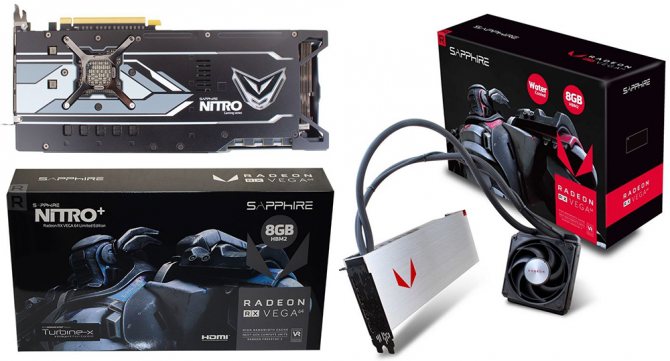
Now a quick breakdown of what, how and why. The issue with Nitro + and Sapphire should not even be touched upon, this is a top solution for all AMD cards and in rare exceptions it was not justified. The price of the model is currently moderate – 57.4 thousand rubles, for which the miners get a high quality video card, excellent overclocking and cooling.
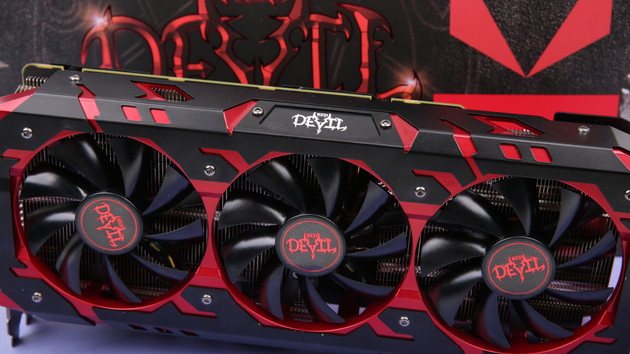
The next option and a direct competitor to the first place is considered to be Red Devil. Excellent cooling, the highest initial factory overclocking and a very favorable price of 55.3 thousand rubles make this card, if not the best option, then a guaranteed second place.
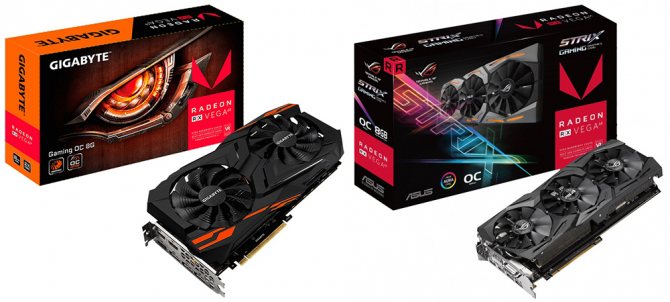
Gigabyte and Asus are competing for 3rd and 4th place, although both manufacturers have their drawbacks. At Asus, that’s the price. RX Vega 64 from this vendor costs 60.2 thousand rubles, although for this price the owners get an excellent card with high-quality cooling and good overclocking (it could compete for the first places if not for the price). But Gigabyte, in the case of this model, decided to save a lot in order to bribe miners with the lowest price. The price of 51.2 thousand rubles is quite excellent for Vega, although the quality of Gigabyte is noticeably inferior to the first three.
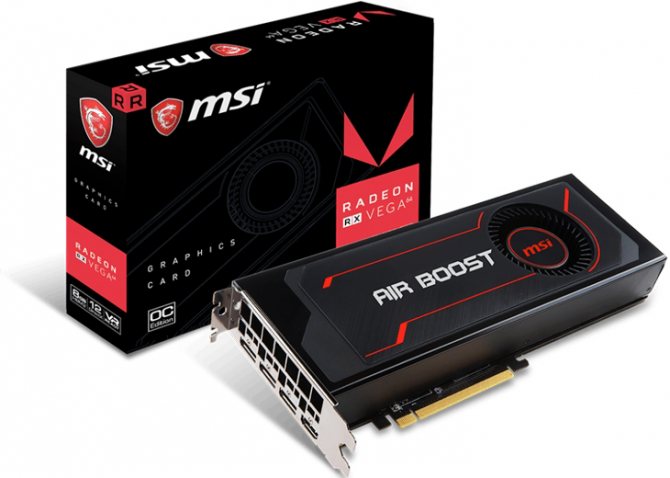
Alas, the solution from MSI is inferior to all competitors. The company has released a classic “turbine” with air cooling and the cost of the video card is currently 57.8 thousand rubles. This makes it uncompetitive against other vendors. The version with CBO is no longer available, although its price was also too high.
⇡#GPU Vega 10
The only GPU of the Vega family, which has been released by AMD so far, corresponds to the Fiji processor in terms of the configuration of the computational units: 4096 shader ALUs, 256 texture mapping units and 64 ROPs. Nevertheless, the number of transistors in the chip increased from 8.9 to 12.5 billion. At the same time, thanks to the 14 nm FinFET process technology, the die area was reduced from 596 to 486 mm2. Thus, Vega 10 is 72% more dense chip than Fiji, and even compared to Polaris, the area is used 5% more efficiently.
Part of the transistor budget that differs Vega 10 from Fiji used up twice the L2 cache (4 MB versus 2 MB in Fiji) for the new rendering features described above, but the lion’s share of the elements allocated in the GPU circuit serves as the basis for additional pipeline stages that AMD had to implement in order to ensure stable operation at increased clock speeds. However, the developers assured that additional stages appeared only in those areas where the benefits of the high frequency outweigh the increased latency. Otherwise, more sophisticated methods were used, including reducing the length of internal connections or completely reworking certain functional blocks.
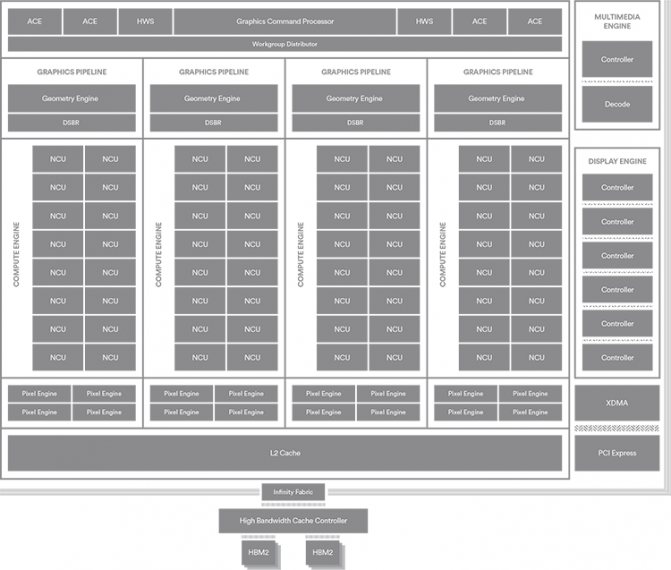
Vega’s internal memory registers are built using static memory originally designed for Ryzen processors, which AMD says provides 18% floor space savings, 43% power savings and 8% latency savings over standard solutions.
By the way, the ROPs inside Vega are now clients of the L2 cache rather than the memory controller. This will increase the performance of lazy rendering engines, since the result of a separate pass will be written directly to L2 instead of RAM and will be immediately available to texture units for the next operations.
For communication inside the chip between the GPU itself and uncore components (RAM controller, PCI Express bus, multimedia unit, etc.) Vega uses the Infinity Fabric interface, which is also part of the Zen architecture processors. Thanks to it, AMD will be able to easily integrate the Vega core into the next generation APU in the future.
The video decoding unit in Vega has not acquired new functions compared to Polaris. It still decodes H.264 and H.265 at resolutions up to 3840×2160 at 120Hz, but AMD has cleared up the hardware support for the VP9 codec, which was first announced for Polaris, but not implemented in the driver. up to the present day. It turns out that Vega uses a hybrid approach, combining dedicated block, shader ALU and CPU resources.
But the encoding unit in Vega acquired the ability to record video in H.264 format in 4K resolution at 60 Hz, while Polaris was limited to 30 Hz.
Vega again uses HBM memory, but because the second version of the technology allows for assemblies up to 8GB, AMD simultaneously has the opportunity to increase the amount of local GPU memory and to simplify the design with fewer chips and simplified wiring. The Vega 10 silicon substrate combines a GPU die with two HBM2 assemblies of 4 GB each with a 2048-bit bus, but due to the almost doubled HBM2 frequency, the processor retains raw memory bandwidth comparable to Fiji’s characteristics.
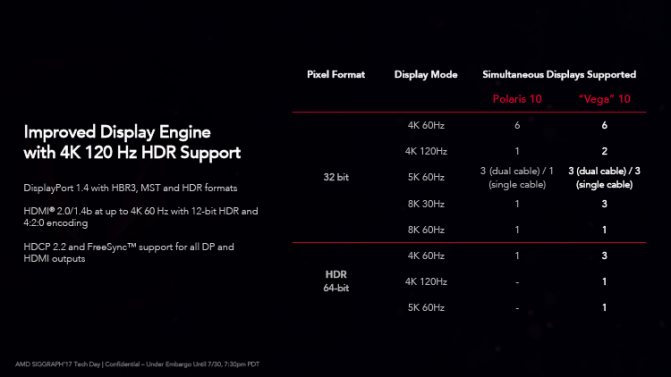
RX Vega 64 mining power and profitability
Now let’s move on to the main thing – the power of the video card when mining cryptocurrencies. An already overclocked and correctly configured card with the appropriate drivers gives the following indicators:
- CryptoNightV7 (Monero) – about 2000 MH / s at 160 watts;
- DaggerHashimoto (Ethereum) – 44-45 MH/s.
It makes no sense to consider mining on other algorithms, because under the limited conditions of GPU mining, only these algorithms on RX Vega 64 are profitable.
How much can this video card bring in the third quarter of 2018? If we take Ether at the current value of the cryptocurrency (during its drawdown), then Vega will bring in about $ 18-19 per month. On Monero mining, the situation is a little better and at the moment the card brings in $ 25-26. When calculating, the average cost of electricity in Moscow was taken, therefore, in regions where the price per kilowatt is lower, the situation may change for the better (but not more than by $ 2-3). About a third of the amount goes to pay for electricity, taking into account the “gluttony” of the card. NiceHash for this video card gives not comforting results at all in the form of $ 13-15 per month.
Payback and price issue
Today the top card from AMD costs around $ 800-830. In terms of cost, it is identical to the GTX 1080 Ti, although it does not match the latter in terms of profitability or power consumption. Also, the model from NVidia is significantly superior in performance and popularity in the gaming field, which can have a strong impact if you want to quickly sell a farm or one RX Vega 64.
It is important to compare one “Vega” with more practical RX 580. At the moment, their price ranges from 22 to 27 thousand rubles for the 8 GB version and 20-21 thousand for 4 GB. Simply put, for the price of one 64th you can buy two top-end RX 580s, and if you limit yourself to an inexpensive model from Asus (8 GB) for 22,000 rubles, then with a small surcharge of 7-9,000 you can take as many as three video cards. What will it give in terms of power? Top RX 580s with the right settings almost always charge 29-30 MH / s on Live. If you are unlucky with memory, which is often the case in “cheap” versions of RX 580, you can still count on 27-28 MH / s.
Taking into account the fact that Vega 64 on Ethereum issues about 44-45 MH / s, the acquisition of two RX 580s will look much more profitable in all respects. Moreover, if you prefer to mine on NiceHash, then RX 64 and 580 will give the same result – $ 13-15. And this despite the fact that the latter is 2-2.5 times cheaper.
The question of payback with such a difference in performance will look incorrect, although it is worth considering that with the best performance (Monero) Vega 64 will bring about $ 25 per month. In such conditions (taking into account other expenses on the farm / solo mining), the payback period for one card will just approach a full three years. Such a long payback period is completely unprofitable, not only by the standards of mining, but also from the point of view of any investment. It is also worth considering that mining on video cards is going through hard times. In addition, NVidia has already begun to announce a new generation of cards that will significantly change the situation on the market and make most of the “old” models unprofitable (in terms of price / power ratio).
Comparison of benchmarks
GPU 1: AMD Radeon RX Vega M GL GPU 2: AMD Radeon RX Vega 56
| PassMark — G3D Mark | GPU 1 |
| GPU 2 |
3284 PassMark — G2D Mark GPU 1 556 Geekbench — OpenCL GPU 1 19488 CompuBench 1.5 Desktop — Face Detection (mPixels/s) GPU 1 58.971 CompuBench 1.5 Desktop — Ocean Surface Simulation (Frames/s) GPU 1 1235.247 CompuBench 1.5 Desktop — T-Rex (Frames/s) GPU 1 5.195 CompuBench 1.5 Desktop — Video Composition (Frames/s) GPU 1 75.289 CompuBench 1.5 Desktop — Bitcoin Mining (mHash/s) GPU 1 252.311 GFXBench 4.0 — Car Chase Offscreen (Frames) GPU 1 6454 GFXBench 4.0 — Manhattan (Frames) GPU 1 2118 GFXBench 4.0 — T-Rex (Frames) GPU 1 1513 GFXBench 4.0 — Car Chase Offscreen (Fps) GPU 1 6454 GFXBench 4.0 — Manhattan (Fps) GPU 1 2118 GFXBench 4.0 — T-Rex (Fps) GPU 1 1513
| Name | AMD Radeon RX Vega M GL | AMD Radeon RX Vega 56 |
| PassMark — G3D Mark | 3284 | 13281 |
| PassMark — G2D Mark | 556 | 769 |
| Geekbench — OpenCL | 19488 | 163998 |
| CompuBench 1.5 Desktop — Face Detection (mPixels/s) | 58.971 | 184.405 |
| CompuBench 1.5 Desktop — Ocean Surface Simulation (Frames/s) | 1235.247 | 1769.359 |
| CompuBench 1.5 Desktop — T-Rex (Frames/s) | 5.195 | 12.703 |
| CompuBench 1.5 Desktop — Video Composition (Frames/s) | 75.289 | 79.32 |
| CompuBench 1.5 Desktop — Bitcoin Mining (mHash/s) | 252.311 | 1022.925 |
| GFXBench 4.0 — Car Chase Offscreen (Frames) | 6454 | 14514 |
| GFXBench 4.0 — Manhattan (Frames) | 2118 | 3717 |
| GFXBench 4.0 — T-Rex (Frames) | 1513 | 3360 |
| GFXBench 4.0 — Car Chase Offscreen (Fps) | 6454 | 14514 |
| GFXBench 4.0 — Manhattan (Fps) | 2118 | 3717 |
| GFXBench 4.0 — T-Rex (Fps) | 1513 | 3360 |
| 3DMark Fire Strike — Graphics Score | 0 | 2 |





